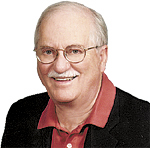It is generally agreed by scholars that Gordon’s Calvary, a rocky outcrop outside the walls of the city of Jerusalem – the word “Calvary” meaning “place of the skull – and the Garden Tomb, which is located approximately 100 yards west of Gordon’s Calvary, are not the actual sites of the crucifixion, burial and resurrection of Jesus.

The oft-visited and greatly revered Garden Tomb, which was discovered in 1867 and which has grown in popularity among Protestants as a sacred place, is viewed today, as it has been for years, as the alternative to the Church of the Holy Sepulchre, which has attracted devotion from Christians since the time of Constantine as the actual “place of the skull” and location of the tomb in which the body of Jesus was laid to rest after his crucifixion.
One problem with the acceptance of the Garden Tomb as authentic is that, based on its configuration, it is dated from the late Old Testament era (9th-7th century B.C.) and could not have been a “new tomb” (Matthew 27:60; John 19:41) at the time of the crucifixion.
Moreover, the burial benches in the Garden Tomb were cut down during the Byzantine period (4th-6th century A.D.), radically disfiguring the tomb and offering evidence that the early Christians certainly did not revere the tomb as the burial place of Christ.
A Holy Land specialist, Carl Rasmussen, has said, “It is my opinion that the Church of the Holy Sepulchre preserves a more accurate tradition.”
The Garden Tomb Association, which is based in the United Kingdom and is in charge of the site, continues to emphasize that it is the resurrection of Jesus, rather than the exact place of his burial, that is of greatest importance.
Still, the Garden Tomb, even with all of the doubt cast upon the authenticity of its connection with Jesus Christ, has lost none of its appeal as a place to contemplate the death, burial and resurrection of our Lord – much more conducive to such pondering than the dark, urban confines of the Church of the Holy Sepulchre. It conforms perfectly to what we imagine as we read of these climactic events as recorded in the gospels.
It was late in the afternoon when I, along with my Southern Baptist editor colleagues and friends, visited the Garden Tomb. Nearby, a church group from the United States held a worship service and I listened with joy to the familiar melody of “Victory in Jesus.”
Later, as dusk arrived and temperatures dropped, our little group made its way to the bus and the return to our hotel. As we drove through the Jerusalem streets with my mind still on the Garden Tomb, I wondered, “If not at the Garden Tomb, then where was Jesus really buried? Most probably, the Church of the Holy Sepulchre.” But then it occurred to me, “It doesn’t really matter. Wherever it was, that tomb is also empty.”
 Southern Baptist journalists standing outside the Garden Tomb, from left, are Norman Jameson, North Carolina; Gary Ledbetter, Texas; Kirkland; Tony Martin, Mississippi; Jim Smith, Florida; Bob Terry, Alabama; and Jim White, Virginia.
Southern Baptist journalists standing outside the Garden Tomb, from left, are Norman Jameson, North Carolina; Gary Ledbetter, Texas; Kirkland; Tony Martin, Mississippi; Jim Smith, Florida; Bob Terry, Alabama; and Jim White, Virginia.